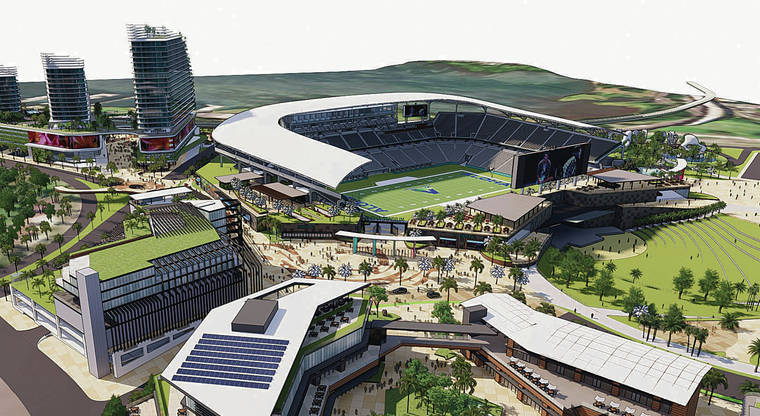With a strongly worded memorandum, the University of Hawaii is pressing the state to grant what it terms “fundamental requirements” it says it needs to be successful in the planned New Aloha Stadium Entertainment District.
In a four-page document that was distributed Thursday to stadium and state officials as well as legislators and has been obtained by the Honolulu Star- Advertiser, UH said the “financial model under which we have been playing our home games at Aloha Stadium does not work for UH and threatens the financial viability of Division I intercollegiate athletics in Hawaii.”
It added that it is “apparent that” the school has “no assurance that the NASED project will be a viable solution to our longstanding financial issues playing at Aloha Stadium.”
Moreover, it says it has been advised that the current Aloha Stadium would likely be demolished at the beginning of the project instead of after the new facility is constructed, potentially leaving the Rainbow Warriors to “identify an alternate site to play football for at least three seasons, 2021-’23.”
The facility, for which the state has appropriated up to $350 million as its share of a proposed public-private partnership with a yet-to-be-selected developer, was initially projected to open in September 2023 but now looks more like 2024.
The letter follows a Dec. 17 Stadium Authority announcement of a “temporary moratorium” on new events for 2021 as well as reduced operations at the 45-year-old facility due to safety restrictions and severe budgetary issues brought on by the impact of COVID-19.
In response to questions from the Star-Advertiser, state Comptroller Curt Otaguro said in a statement Friday, “We appreciate the feedback from UH and will have considerable discussions about the items in the letter. Unfortunately, the pandemic has had an unforeseen impact on the financial situation at Aloha Stadium, which necessitated the recent actions announced by the Stadium Authority. There was no way to anticipate this turn of events, so we are doing our best to make fiscally responsible decisions in light of the stadium’s budget crisis.”
Otaguro’s statement added, “In regards to the NASED project, we met with UH and other stadium tenants early in the process and we continually encourage them to share additional input with us as we move through the various stages of the environmental impact statement.”
A developer to partner with the state is expected to be selected late this year, and Otaguro’s statement said, “After a developer is selected following the request for proposal process, we will engage with all stadium tenants more intensely to ensure that the new stadium addresses their specific needs. We understand that UH would like a different financial arrangement with the new stadium and we will have those discussions at the proper time. Currently, it’s too early, since we are only in the preliminary planning stages.”
UH charged, “Our current assessment is that UH is at best the fourth priority in making NASED decisions after (the Department of Accounting and General Services) and the Stadium Authority enters into a contract. UH will be considered after the financiers, after the developer, and after the Stadium Authority or other operator. The Stadium Authority did not disagree with this assessment. So, while ostensibly the anchor tenant, UH has no direct input into the RFP criteria, process, selection of contractor(s) or provisions of the contract that the state will enter into. In the meantime, UH is being forced to fend for itself to identify and prepare a home field for football for at least 2021-2023, likely longer, and potentially indefinitely.”
UH, which holds an ex officio position on the Stadium Authority and often has a representative at the meetings, said it was briefed five days in advance of the announcement.
UH wants include no rental or facilities cost for football games; 50% of net concession, merchandise and parking revenues; UH keeping all ticket receipts, including preferred-seating donations; and a “minimum” of 50% of the luxury boxes to sell for its football games.
UH acknowledged that while it knew “the situation was dire, we had originally expected that we would be able to play at Aloha Stadium, likely with reduced fan attendance, until the new stadium was built. The decision to abandon the original plan to build the new stadium alongside Aloha Stadium, which would have been demolished after the new stadium was available, took place without UH consultation or engagement.”
—
UH stadium demands
(UH “fundamental requirements” for the new stadium)
>> Paramount consideration in scheduling
>> No rental or facilities cost for football games
>> All ticket receipts, including preferred-seating donation revenue for football
>> Revenue from premium parking
>> A minimum of half of the luxury boxes to sell for UH games
>> Revenue from “club” area membership fees for UH games
>> A minimum of half of net concession and merchandise revenue
>> A minimum of half of net parking revenue
>> Rights to sell advertising for UH football games and retain the funds
Source: UH memorandum

